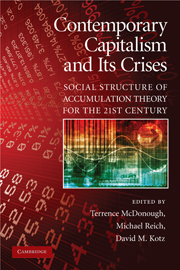Book contents
- Frontmatter
- Contents
- List of Tables
- List of Figures
- List of Contributors
- Acknowledgments
- Introduction: Social Structure of Accumulation Theory for the 21st Century
- PART I THE THEORY OF SOCIAL STRUCTURES OF ACCUMULATION
- 1 The State of the Art of Social Structure of Accumulation Theory
- 2 Social Structure of Accumulation Theory
- 3 A Reconceptualization of Social Structure of Accumulation Theory
- PART II GLOBALIZATION AND THE CONTEMPORARY SOCIAL STRUCTURE OF ACCUMULATION
- PART III THE CONTEMPORARY SOCIAL STRUCTURE OF ACCUMULATION IN THE UNITED STATES
- PART IV SOCIAL STRUCTURE OF ACCUMULATION THEORY AND TRANSFORMATIONS OF THE CAPITALIST PERIPHERY
- Index
- References
1 - The State of the Art of Social Structure of Accumulation Theory
Published online by Cambridge University Press: 05 June 2012
- Frontmatter
- Contents
- List of Tables
- List of Figures
- List of Contributors
- Acknowledgments
- Introduction: Social Structure of Accumulation Theory for the 21st Century
- PART I THE THEORY OF SOCIAL STRUCTURES OF ACCUMULATION
- 1 The State of the Art of Social Structure of Accumulation Theory
- 2 Social Structure of Accumulation Theory
- 3 A Reconceptualization of Social Structure of Accumulation Theory
- PART II GLOBALIZATION AND THE CONTEMPORARY SOCIAL STRUCTURE OF ACCUMULATION
- PART III THE CONTEMPORARY SOCIAL STRUCTURE OF ACCUMULATION IN THE UNITED STATES
- PART IV SOCIAL STRUCTURE OF ACCUMULATION THEORY AND TRANSFORMATIONS OF THE CAPITALIST PERIPHERY
- Index
- References
Summary
This chapter provides an overview of the state of the art of the social structure of accumulation (SSA) literature produced since 1994. Any such project must start with David Gordon's last contributions before his untimely death in 1996. In addition, there have been a number of contributions from the academic discipline of sociology, including the founding of a “spatialization” school extending the work of Gordon, Edwards, and Reich's original Segmented Work, Divided Workers. There have been a number of works extending the geographic reach of the SSA framework to new areas, most prominently to developing countries. Several authors have applied the SSA framework to the history and analysis of specific institutions. Such an overview is supplied in the first section below. Following that section we will assess the theoretical contributions made by these works in the last ten years or so. Finally, we will discuss the debate over whether a new SSA was consolidated after the stagflation crisis of the 1970s and early 1980s. If an SSA was consolidated, the current economic crisis results from the disintegration of that SSA. If an SSA was not consolidated, what we are witnessing today is the continuation of the unresolved collapse of the postwar SSA.
An Overview of the Last Decade
David Gordon's Last Works
David Gordon's continuing contributions were primarily in the area of building econometric models that drew on the insights of SSA analysis to provide an alternative representation of the dynamics of the U.S. economy in the postwar period.
- Type
- Chapter
- Information
- Contemporary Capitalism and its CrisesSocial Structure of Accumulation Theory for the 21st Century, pp. 23 - 44Publisher: Cambridge University PressPrint publication year: 2010
References
- 9
- Cited by



